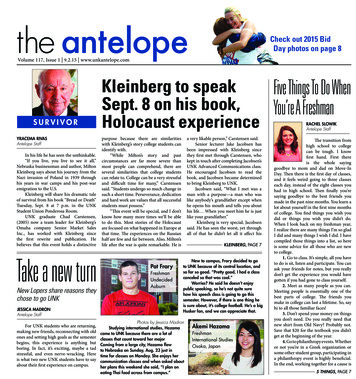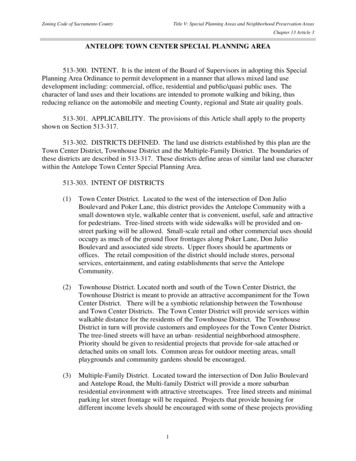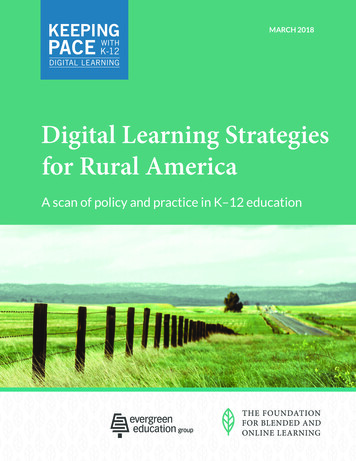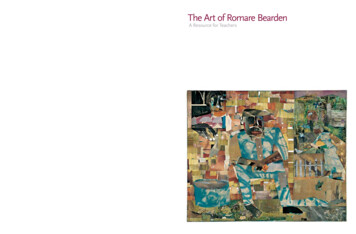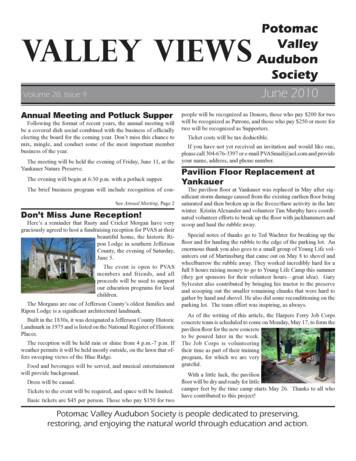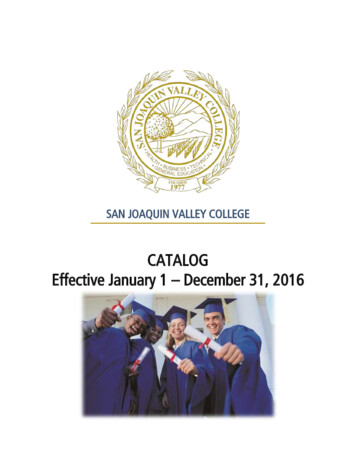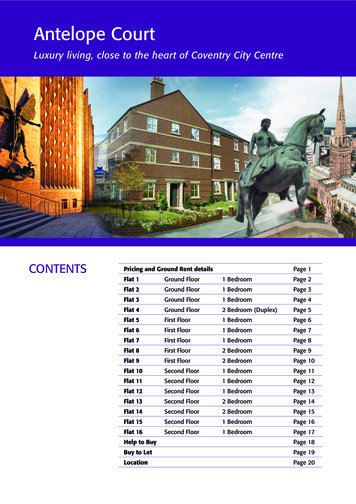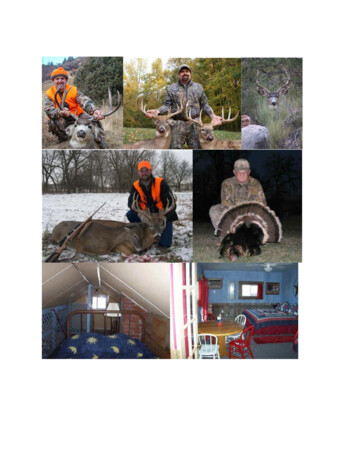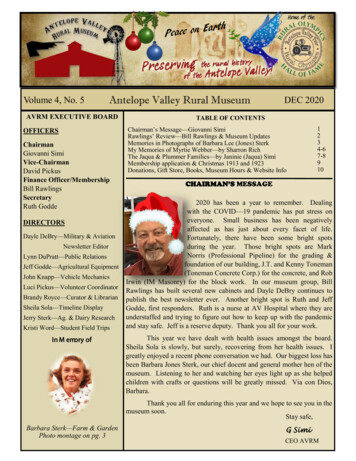
Transcription
Volume 4, No. 5Antelope Valley Rural MuseumAVRM EXECUTIVE BOARDOFFICERSChairmanGiovanni SimiVice-ChairmanDavid PickusFinance Officer/MembershipBill RawlingsSecretaryRuth GoddeDIRECTORSDayle DeBry—Military & AviationNewsletter EditorLynn DuPratt—Public RelationsJeff Godde—Agricultural EquipmentJohn Knapp—Vehicle MechanicsLuci Pickus—Volunteer CoordinatorBrandy Royce—Curator & LibrarianSheila Sola—Timeline DisplayJerry Sterk—Ag. & Dairy ResearchKristi Word—Student Field TripsIn M emory ofDEC 2020TABLE OF CONTENTSChairman’s Message—Giovanni SimiRawlings’ Review—Bill Rawlings & Museum UpdatesMemories in Photographs of Barbara Lee (Jones) SterkMy Memories of Myrtie Webber—by Sharron RichThe Jaqua & Plummer Families—by Janinie (Jaqua) SimiMembership application & Christmas 1913 and 1923Donations, Gift Store, Books, Museum Hours & Website Info1234-67-8910CHAIRMAN’S MESSAGE2020 has been a year to remember. Dealingwith the COVID—19 pandemic has put stress oneveryone. Small business has been negativelyaffected as has just about every facet of life.Fortunately, there have been some bright spotsduring the year. Those bright spots are MarkNorris (Professional Pipeline) for the grading &foundation of our building, J.T. and Kenny Toneman(Toneman Concrete Corp.) for the concrete, and RobIrwin (IM Masonry) for the block work. In our museum group, BillRawlings has built several new cabinets and Dayle DeBry continues topublish the best newsletter ever. Another bright spot is Ruth and JeffGodde, first responders. Ruth is a nurse at AV Hospital where they areunderstaffed and trying to figure out how to keep up with the pandemicand stay safe. Jeff is a reserve deputy. Thank you all for your work.This year we have dealt with health issues amongst the board.Sheila Sola is slowly, but surely, recovering from her health issues. Igreatly enjoyed a recent phone conversation we had. Our biggest loss hasbeen Barbara Jones Sterk, our chief docent and general mother hen of themuseum. Listening to her and watching her eyes light up as she helpedchildren with crafts or questions will be greatly missed. Via con Dios,Barbara.Thank you all for enduring this year and we hope to see you in themuseum soon.Stay safe,Barbara Sterk—Farm & GardenPhoto montage on pg. 3G SimiCEO AVRM
RAWLINGS’ REVIEWWe also owe Johnny Zamrzla and his familybusiness Western Pacific Roofing big thanks fordoing siding and roofing to cover the roof structure.Not Just a Donor Wall, butthis giant portable displaywill also be a Memorial wall.With over 220 square feet ofrepurposed rustic corrugatedsteel wall space, we will beable to acknowledge all thepeople, businesses, and groupswho through their generosityhave made our growth and local history preservationpossible. One whole face and at least one end panelwill hold the DONOR lists, while the remaining areawill feature Memorials to those deceased volunteerswho worked hard to improve the AVRM, as well aslists of those who donated in memory of family andfriends. Thus the ANTELOPE VALLEY RURALMUSEUM DONOR & MEMORIAL WALL hasbeen built.We also acknowledge the efforts of our designteam of Giovanni Simi, Renato DeGuia, DebbieDino, Angie Hughes, Kathy MacLaren, and me forfinding the appropriate design for this project.Currently our donor levels are GOLD, SILVER &BRONZE. We may be adding PLATINUM as thehighest donor level. The greater the donation thegreater its prominence will be on the wall.The BRONZE level is for donations of 100 999 The SILVER level is for donations of 1,000 9,999 and will show levels of 1,000, 2,500, 5,000, & 7,500. The GOLD level is for donationsof 10,000 and greater and will differentiateincreasing levels of 15,000, 25,000, 50,000, 100,000.Donations are cumulative so that as donorscontribute greater amounts their names advance tohigher levels.Merry Christmas to all our friends and supporters.May we all have a safe and joyful Holiday Season!Bill RawlingsFinance OfficerShopping & Giving Many of you are buying giftsand other goodies online due to so many storeclosures and restrictions this crazy year.I hope youwill consider going to smile.amazon.com andchoosing Antelope Valley Rural Museum ofHistory as your charity. When you shop atsmile.amazon.com, Amazon donates a portion ofyour purchase price to your favorite charity. It willcost you nothing but a couple of minutes of yourtime.Building the wall required many volunteers.Pictured just after the roof section was mounted tothe base structure are Bill Rawlings, Jeff Godde,Jared Adams, & John Calvert.David Pickus, Jerry Sterk & Pam Rawlings alsoworked on the wall. Thanks to Jess Baker forsalvaging metal from a Forestry Service building.2Be sure and check out our website and browse ourGift Shop at https://www.avmuseum.org/shop/
Remembering the great times with Barbara Lee (Jones) Sterk1935—2020We all miss you very much. Thanks for the wonderful memories.and your beautiful smile!3
The following memories were written by Sharron Rich, great-granddaughter of Myrtie (Gibson) Webber, theowner/proprietor of the Western Hotel on Lancaster Blvd. in Lancaster, California. I met Sharron when she cameto visit her father’s grave several years ago—Ray Paul York—who is interred at Lancaster Cemetery. Sharron hasdonated several photographs to the Antelope Valley Rural Museum. The photos used here are some of the mostrecent. I have never seen these photos before, so it is quite a treat to receive them! Dayle DeBry, EditorMY MEMORIES OF THE WESTERN HOTELBy Sharron RichI am the great-granddaughter of Myrtie E. and George Webber,past owners of the Western Hotel, now known as the Western HotelMuseum. I was born and raised in the hotel until I was 11 years ofage. My mother, (granddaughter and daughter of Myrtie andGeorge, explanation coming) Frances M. Holloway, (nee Webber)lived in the hotel when pregnant with me and I came so fast that shecouldn’t make it across the street to the hospital! I was her thirdchild. She was taking a nap in the afternoon, suddenly went intolabor, and I was born. I am the only one of six kids born in thehotel. I was born in 1943 in the middle of World War II.A few weeks after I was born, I came down with doublepneumonia. Penicillin was just then being used for infections andwar wounds, but the doctor suggested I have penicillin to save mylife. Penicillin was not for public use at the time, and the doctor hadto get permission from the military to use it for my pneumonia.Permission was granted, the drug saved my life, and I am still heretoday. There was a headline in the local Lancaster Gazette whichstated, “Miracle Drug Saves Baby.” My 15 minutes of fame camevery early in life!Frances Holloway (Webber) was the granddaughter of Myrtie E.Webber. Frances was the daughter of Myrtie’s son Frank Sullivan,from Myrtie’s first marriage prior to her marriage to GeorgeWebber. Frank Sullivan and his wife had two daughters, Francesand Charlotte, my aunt. Mr. Sullivan abandoned his wife andchildren and Mrs. Sullivan (my grandmother Eugenia) was put inan institutional home for the rest of her life. (Editor’s note:Eugenia’s death certificate states she had idiopathic epilepsy. Shedied of a cerebral hemorrhage in a sanitarium in 1948.)That left two young daughters to be raised. Myrtie and GeorgeWebberadopted Frances and Charlotte and became theirGeorge Webber, left, Eugenia Sullivan, Frances Sullivan andgrandchildren’smother and father! My mother and aunt both grewMyrtie Webber, 1920s.up in the hotel with the Webber’s and assumed their last name.My mother Frances Webber married Ray Paul York in 1938. She had my two oldest brothers, Douglas and Richard, andthen me. By the time she was pregnant with me, she had filed for divorce from Ray and had moved back into the hotel withMyrtie Webber. At that time, she was helping Myrtie run the hotel (George Webber died of stomach cancer in 1934) alongwith raising her three children in the hotel. In 1945 Frances married Lee Holloway, who adopted Douglas and Sharron, soour names were then changed from York to Holloway. My brother Richard was awarded to my father so he kept the lastname of York. Life is sometimes very complicated.The hotel, when I lived there, was attached to my Grandma Webber’s house (we called her Grandma). There was aswinging door from her dining room to our kitchen on the west side of the hotel and well behind the lobby. I spent a greatdeal of time with my Grandma Myrtie. Grandma’s house was on the west side of the hotel, set back a ways, and had a livingroom, dining room, large kitchen, bath, and two bedrooms. The Webber house has since burned down. Behind myGrandma’s house was a large, three-story water tower. There were two hotel rooms in the water tower—one up and one onthe ground floor. The water tower was free standing (see photo on next page). There was also a free standing “apartment”behind the hotel and across from Grandma’s house. Both the water tower rooms and the apartment were permanently rentedto me who traveled with their jobs.At one point we had cooks who lived in the hotel and cooked for our family. One was a woman named Ms. Murphy, andthe other was a Mr. Ruvolo who had a son. Mr. Ruvolo was straight from Italy and was a delightful man to be around.4
He cooked the best Italian food we had ever eaten at that time! Ms. Murphy made the best peanut butter cookies I hadever tasted. She also had a Basque boyfriend who visited when the sheep were brought down from the mountains forslaughter. There was a black lady name Xoni, who came and helped clean. She and her husband Philip were the onlyblack people in the town when I was growing up there. They lived on a chicken farm right outside the town boundaries.I remember visiting Xoni and Philip to get eggs and fresh chicken.My family lived in the section of the hotel right behind the lobby. Our living room opened up into the lobby. Behindthe living room was a bedroom that I shared with my younger half-sister and half-baby brother. My older brotherDouglas lived in room No. 2 in the hotel. My other brother Dick shared that room whenever he came to visit us, as helived with Ray York, our biological father. Behind my bedroom was my parent’s bedroom, which also served as adining room. Behind that was the kitchen, and then behind the kitchen was the family bathroom and the laundry room,which then led to the outdoors. That is where I lived the first 11 years of my life.In 1951, the hotel was the Democratic headquarters for the Presidential election. I remember clearly many meetings inthe lobby, and being sent up and down Lancaster Blvd. to put fliers on people’s cars to get them to vote for AdlaiStevenson. Of course, Eisenhower won!The lobby of the hotel was very plain and painted white or light cream when I lived there. There was a couch under thebig picture window looking out on Lancaster Blvd. There was a pot-belly stove on the back wall, to the left of whichhung a huge deer head on the wall. There were two rocking chairs on the west side of the lobby as well.When I was about nine years old, my mother decided to open up a donut shop in room No. 1. It had a window lookingright out on Lancaster Blvd and the sidewalk. People walked by every day on the sidewalk going and coming from thePost Office next door and other destinations. She installed a huge donut machine and we sold donuts out of a specialsliding window which replaced the original double-hung window. I and my siblings frosted the donuts and sold them aswell.My siblings and I were expected to learn to clean the rooms, make and change the beds, sweep and empty baskets, Weall worked in the hotel at some time or other. The hotel accommodated only men. Because there was only one bathroomon each floor, state regulations prohibited both sexes from staying at the hotel, so only men were clients.There used to be two large palm trees which grew right in front of the hotel. They were the markers of the hotel formany, many years. When cleaning upstairs rooms, we used to go out on the balcony facing Lancaster Blvd. to shake therugs. Clientele also went out on the balcony to smoke. If one looked into the palm trees, you could see rat’s nests, oldcigarette butts, and soda and beer cans. They tops of the palm trees periodically had to be cleaned out. The trees havesince been removed (and moved).I clearly remember the late summer parade that accompanied the Antelope Valley Fair that went down Lancaster Blvd.Every year we made costumes and floats to be in the parade. A couple of times we won best costumes and floats. Mygrandma, Myrtie Webber, was always involved in the sewing of our costumes. She was an excellent seamstress.Grandma made many of my clothes when I was younger. There was always a central theme to the parade. It waswonderful that the parade passed right in front of the hotel—one of my best childhood memories.Another great memory was the Sacred Heart Catholic Church annual barbeque. I loved walking up the block from thehotel and watching the men dig the huge ditch, fill it with rocks and flammables, then when ready they would throw bigbags of beef on top, cover them with dirt, and let them cook for two or three days. The meat was delicious!Grandma Webber was also an excellent cook. Her fried chicken was to die for! Her apple pies were the best I haveever eaten and she always made everythingfrom scratch. She made fruit bar cookies thatshe kept in a huge apothecary jar in her kitchen.The jar was always filled. Grandma allowed meto drink coffee with her when I turned seven.She would make me a little demitasse cup withloads of cream and sugar and a very little bit ofcoffee. Grandma Webber was a big coffeedrinker. I don’t remember her without a cup ofcoffee somewhere in the house. She didn’tdrink spirits, but she loved her coffee!I was born when Grandma was 78, and shewas able to babysit me for years. She was alsoable to chase me and catch me when I was bad!One time in the late 1940s, my GrandmaWebber acquired a “new fangled” gas stove. Itdid not have an automatic pilot light. She waslighting the oven for use when it didn’t catch.She didn’t turn off the gas, but lit anothermatch to light the pilot. There was a hugeexplosion and my poor Grandma was burnedover her arms, face and neck. I rememberclearly how she was covered with bandages forGeorge Webber with Charlotte & Frances Webber, 1920s.55
the burns. It was rather frightening for me as a young girl. I loved her dearly.Another time, my Grandma had a hot water heater that exploded and blew her out the front of her house into a waterfountain that she used to have in her tiny front yard. Miraculously, she wasn’t injured. She had a few bruises but nobroken bones. That happened before I was born. The water fountain was long gone by the time I came along. Her littlefront yard was along the west side of the hotel adjacent to the Post Office property and was fenced in with a gate openingonto Lancaster Boulevard’s sidewalk. I spend a lot of time playing in her front yard.There was an alley that ran down the east side of the hotel. On the other side of the alley was the five and dime storewhere I used to browse as a kid, and where I bought my penny candy.Those are a few of my memories of living in the Western Hotel. I was very pleased to see the hotel being preserved,although it doesn’t look anything like it did inside when I lived there. I suspect it looks more like it did at the turn of the20th Century. The bust of my Great-Grandma Myrtie at the hotel is quite nice. She would be very pleased at being sokindly remembered!All photos courtesy of Sharron Rich, colorized by D. DeBry.Above: Myrtie (Gibson) Sullivan Webber, early 1900s.Above right: George Webber with palm tree, 1925.Right: Myrtie with granddaughters Frances and Charlotte,1920s. The girls were adopted by George and Myrtie aftertheir mother, Eugenia Sullivan, was placed in a sanitarium.They took the Webber name after the adoption.6
THE JAQUA & PLUMMER FAMILIESBy Janine SimiThe first of my family to arrive in Lancaster was my grandfather,Donald Jaqua, Sr. who came in 1934. He worked for FernandoMill out of Van Nuys and they wanted him to manage theirLancaster location. He was born in San Francisco in 1898,worked in many types of jobs, from butcher to airline machinistfor Howard Hughes, before and after his service in the army inWWI, and married Sara Attix with whom he had correspondedduring the war. They had 2 sons, my father Lee Sheldon Jaquaand Donald Jaqua, Jr. They were in their final years ofelementary school when the family moved to Lancaster.William Dewey and Marie Marcy Plummer, my maternalgrandparents, moved to Lancaster in 1935 after Dewey and acolleague, Art Westcott, decided to partner in the establishmentof Westcott & Plummer Drugstore. From the stories I’ve heard,the soda fountain is as remembered as the pharmacy portion ofthe business! Dewey was born in Kansas in 1899, but moved toDonald Jaqua Sr. and Sara Attix Jaqua.Janine (Jaqua) Simi photos, colorized by D. DeBry Lander, WY where he became the first licensed pharmacist in thestate after serving in the army in WWI. Upon seeing MarieMarcy for the first time outside the office where she worked, he said, “I’m going to marry that girl!” Theirdaughter, Thelma Genevieve, was born in Lander a few years later.Did you know Antelope Valley High School had a swimming pool? That’s where Thelma Plummer andSheldon Jaqua met before they started high school, but apparently itwasn’t a moment like when Thelma’s dad first saw her mom. Thelmabecame known for excelling as a violinist and Sheldon for his naturalathletic ability. Sometimes he would play in a baseball game and run ina track meet on the same day. He still holds a record at AV High Schoolfor a low hurdle event. Oh, wait, that event was removed fromcompetition after that year! Thelma went to UCLA and earned ateaching credential while Sheldon earned an AA degree after attendingAV and Ventura Junior Colleges. It would be after WWII and openingJaqua & Sons building materials with his dad and brother for Sheldonand some years of elementary school teaching for Thelma before theywould again connect, marry, and raise three children, Marcy, me, andRandy. There would eventually be six grandchildren and nine greatgrandchildren as of this writing.A third local business also had family ties - Bishop & LusherElectric was started by two of Sara Jaqua’s nephews. In 1948 Sara andDon Jaqua Sr. built the first house out of Jaqua & Sons blocks on thesouth side of Lancaster Blvd. close to 17th Street West. By the late 1950sthere were three block houses owned by Don Sr., Sheldon, and Don Jr.and their wives on Lancaster Blvd. They weren’t next door neighborsthough, there was a house in-between. Dad always said that was neededspace so no one would argue!7Sheldon and Thelma Jaqua.
A favorite story told to us by my Grandpa Jake was about the importanceof education when he didn’t get a job at an oil company. The manager knewhim, was aware of how hard he worked, and wanted to hire him. However,the company had a rule, even in the 1920’s to drive a truck, that theiremployees had to have a high school diploma. As the oldest child, Don’sformal education ended when he graduated from 8th grade so that he couldcontribute to the family income. His sons learned that more education, anAA degree, was needed before they became Navy pilots in World War II.Sheldon flew Hellcat fighters off the USS Hancock and Donald Jaqua, Jr.flew dive bombers.The Antelope Valley Fair and the Rural Olympics are an important partof the Jaqua family history with Don Jaqua Sr. having been called the‘Father of the Antelope Valley Fair’ and known as the originator of the RuralOlympics. Don Sr.’s first known fair experiences dated back to 1914 inSouthern California where he rode the County Fair Rodeo Circuit and in theState Fair as a western rider. Family involvement in the AV Fair started in1938 with Don Sr. and continues with family members today.Sheldon Jaqua, World War II.Don Sr., Sheldon, and Randy were all fair directors. The three of them andDon Jr., my husband Giovanni Simi, our son and son-in-law Tylor Simi and Evan Dow, and Randy’s childrenTravis Jaqua and Calli Zamrzla have all been or still are Rural Olympic committee volunteers. Giovanni did nothave the opportunity to know his grandparents and became quite close to mine. He considers it an honor to haveserved as the chairman of the Rural Olympic committee that my grandfather began decades ago.Left: Donald Jaqua, Sr. and Sara Attix Jaqua with W. Dewey Plummer and Marie Marcy Plummer.Right: Donald Rex Jaqua, Jr., World War II.8
THANK YOU FOR SUPPORTING THE AVRM!Los Angeles TimesDecember 23, 1913Lancaster Throws Off Dull Care and Proceeds toCelebrate in True Yuletide Fashion.Lancaster, Dec. 21.—The Christmas holidays are athand and many social affairs are planned for the nexttwo weeks. Wednesday evening, under the auspices ofthe Methodist church, exercises will be held in theW.I.C. Hall, to which all the children of Lancaster havebeen invited. A programme of music has been arrangedand a beautiful Christmas tree provided.Miss Rebecca Ditman entertained her pupils and theirparents at the Del Sur schoolhouse. The scene of theevening’s festivities was beautifully decorated, while alarge Christmas tree covered with ornaments addedmuch to the charming scene. The manner in which thelarge number of guests were entertained left nothing tobe desired.9Los Angeles TimesDecember 25, 1923Antelope Valley Turkeys For Many.Sixteen Hundred Homes Here Get Birds UnderNovel Marketing PlanSixteen hundred Los Angeles families today willgroup about their Christmas tables on each of which,as the center of attraction, will repose a fine fat turkey.The antelopes left the valley years ago, but their placeshave been taken by thousands of turkeys and nobodycomplains.Because the turkey raisers have had trouble in thepast disposing of their “crop,” this year M.G. Taylor,president of the Antelope Valley Bank at Lancaster,and R.C. Hitte, president of the Lancaster Feed andFuel Company, arranged for the sale of the turkeysdirectly to the consumer.Four Los Angeles banks and several oil companiestook most of the turkeys and arranged matters so thattheir employees could buy the birds at cost. All of thebirds have been freshly killed, and yesterday they werebought into Los Angeles by trucks. The trip took but afew hours. In 1890 the Antelope Valley people used todrive their turkeys to Los Angeles, seventy-five miles,at the rate of six miles a day!
Website: www.avmuseum.orgwww.facebook.com/Antelope Valley Rural MuseumMailing address:AVRMP.O. Box 1316Lancaster, CA 93584Contact us:avmuseum@verizon.netDonate and pay dues via PayPal andcredit card on our websiteDONATIONSPickus Challenge 2020—2021Building FundHonor the Past Plaques andDisplay Sponsorship(Custom laser cut wood plaques withPersonal memorial or message)Bronze Sponsorship DonorSilver Sponsorship DonorGold Sponsorship DonorANTELOPE VALLEY RURAL MUSEUMGIFT STOREAnnual membership dues 20.00Hats—all baseball hats (Members) 10.00Hats—all baseball hats (Non-members) 15.00Lancaster, CA Through Time 25.00History books—all books are priced at:Images of America “Lancaster” 20.00Images of America “Palmdale”Legendary Locals of the AV(Above AV history books signed byNorma Gurba)P-38 LightningImages of America “Edwards Air Force Base”DVDs Listed DVDs are priced at: 20.00 1,000Jane Pinheiro Wildflowers NEW!Yester Years—AV History 1876—19421987 Rural Olympics (narrated) 1,500Evolution of the Rural Olympics book(On DVD—Excel & Word Doc format) 100 1000 10,000The AVRM is a 501(c)(3) public charityEIN: 27-1002922MISSION STATEMENT: The AVRM will honor the history of theAntelope Valley with documentation, preservation, exhibition, andeducation.UPCOMING EVENTS IN 2020Antelope Valley Rural MuseumP.O. Box 1316Lancaster, CA 93584Museum is closed until further notice due to the COVID—19. Weappreciate your understanding and hope you are all doing well.
the living room was a bedroom that I shared with my younger half-sister and half-baby brother. My older brother Douglas lived in room No. 2 in the hotel. My other brother Dick shared that room whenever he came to visit us, as he lived with Ray York, our biological father. Behind my be
